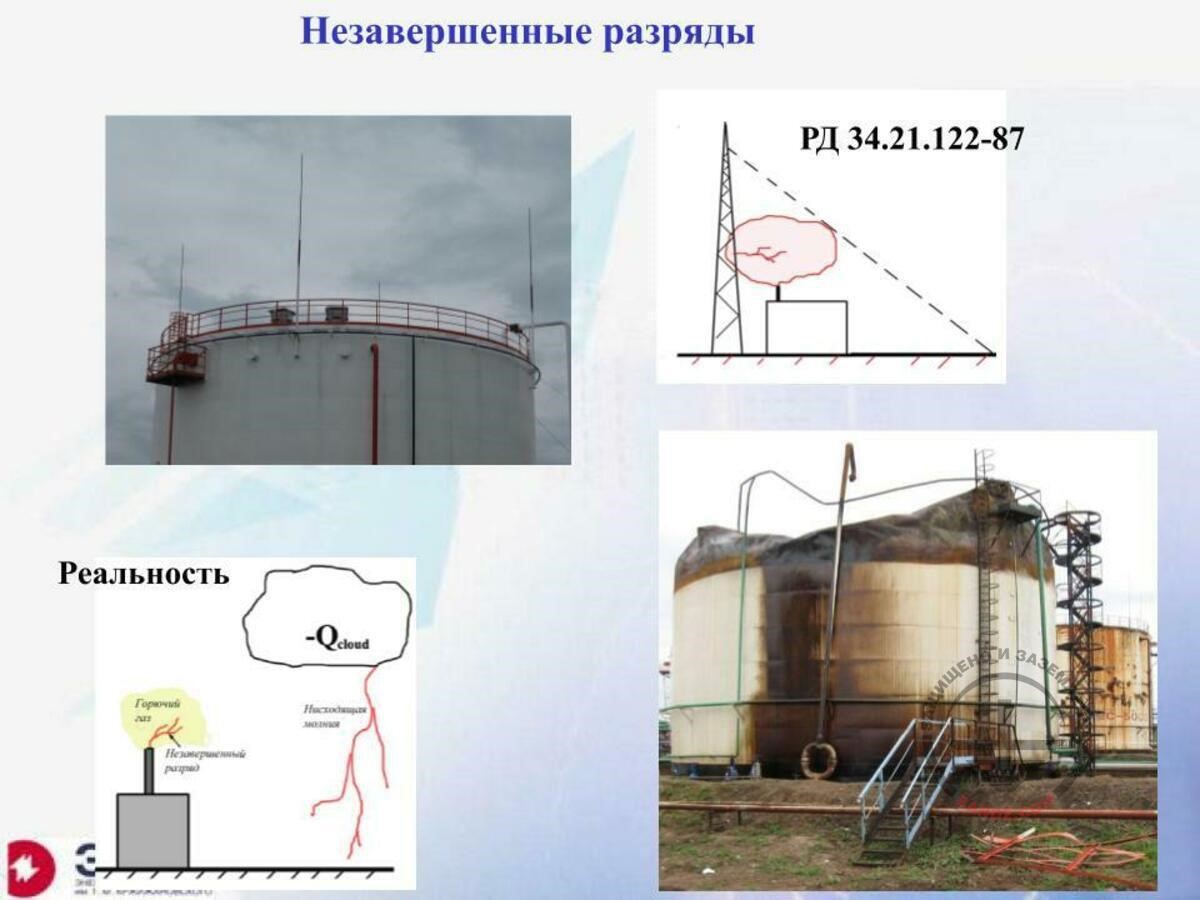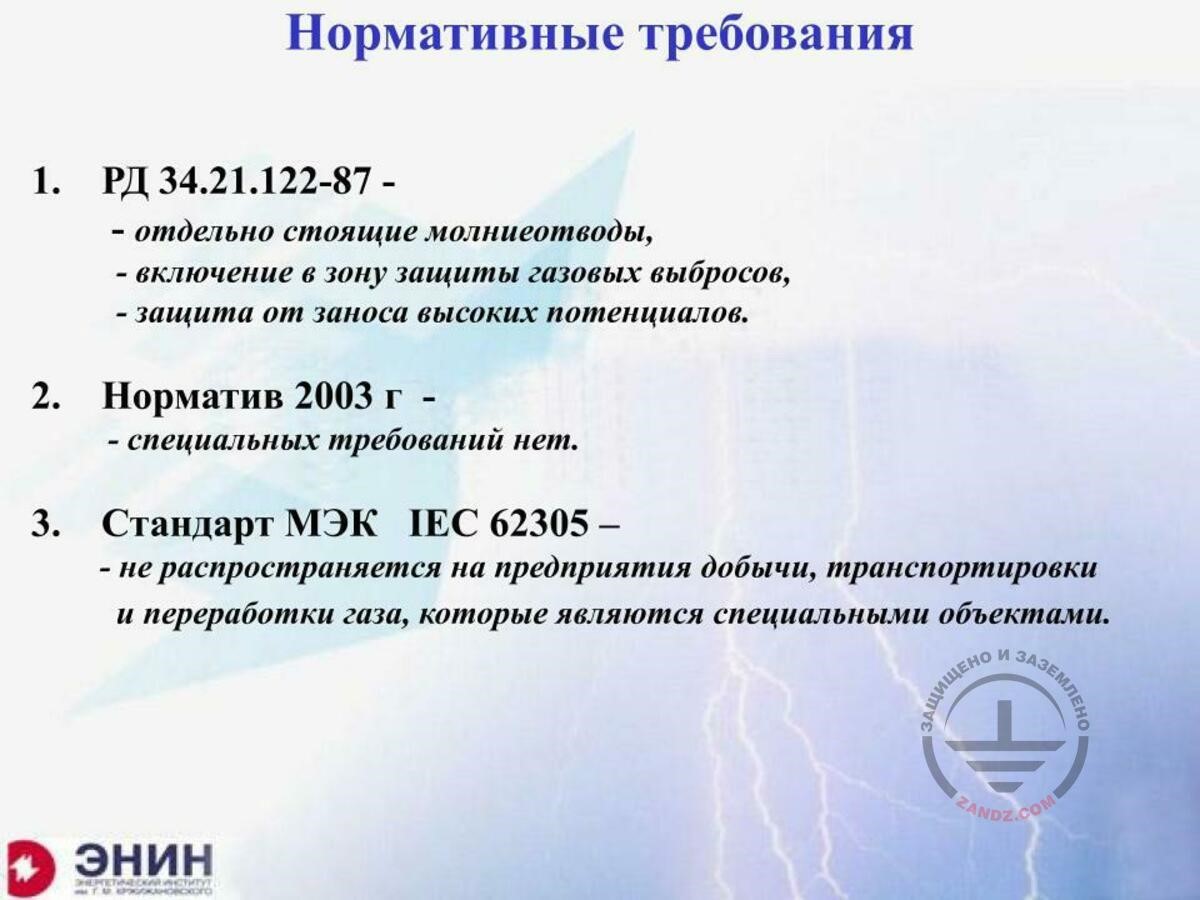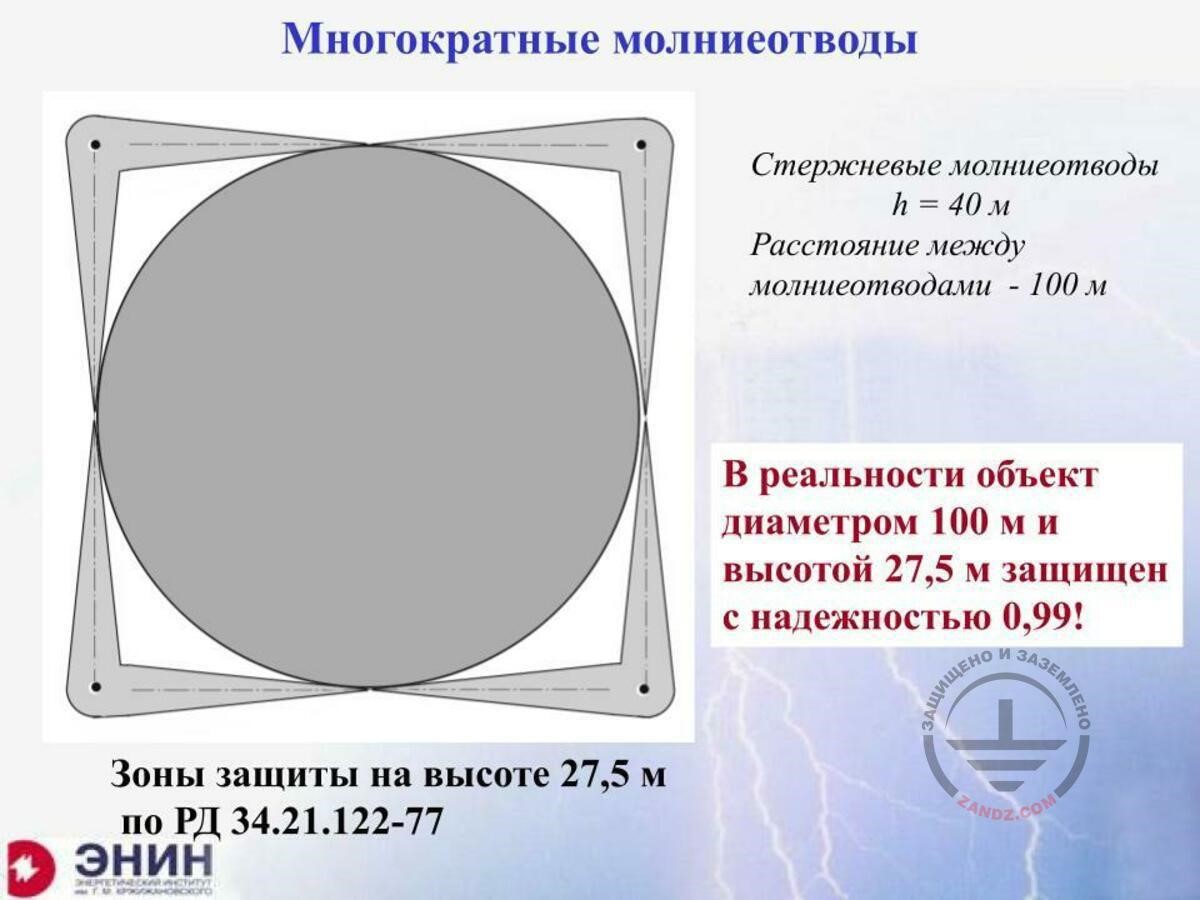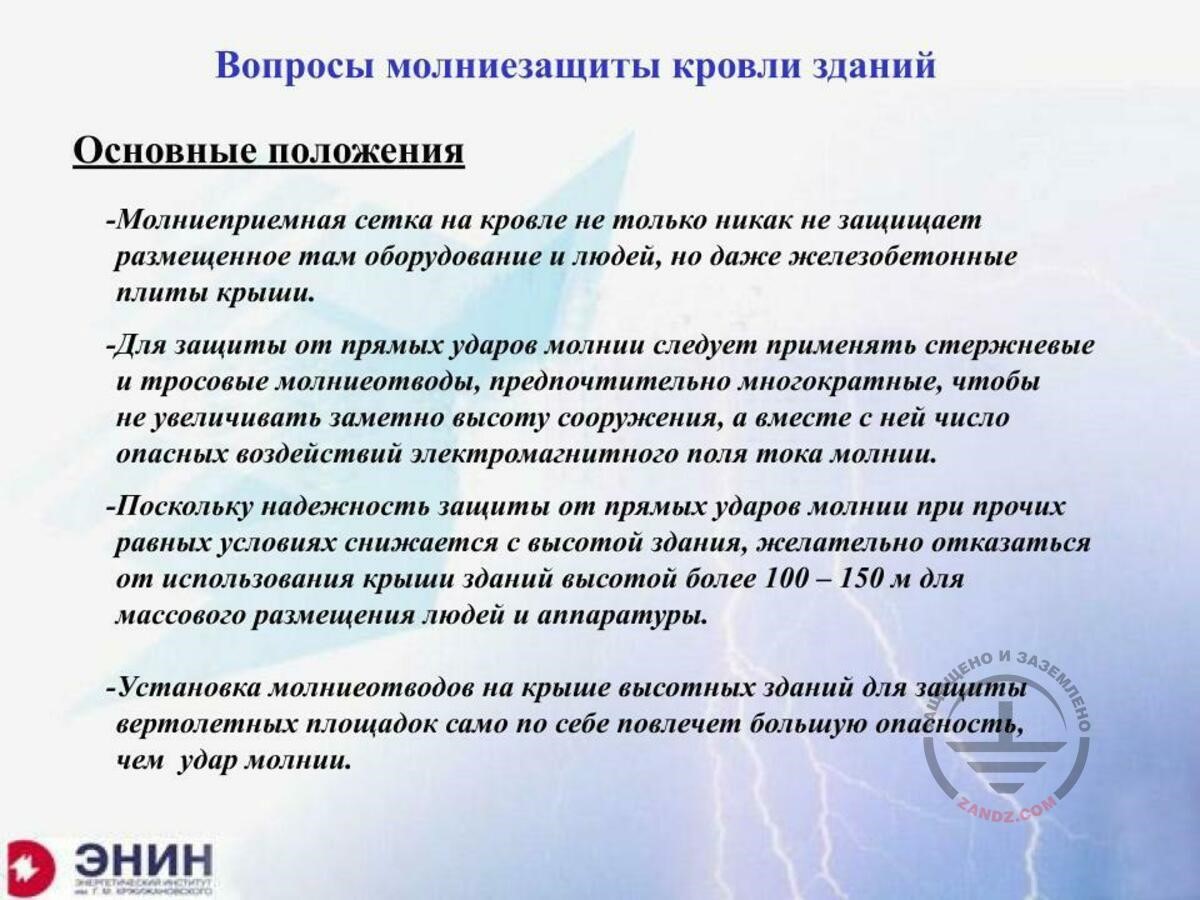Webinar text. Page 2
Fast navigation by slides:
<< Page 1:
1. Fire safety
2. Lightning parameters
3. Lightning is a poor fire-setter!
4. Rated parameters
5. Lightning energy as a whole
6. Thermal impact of lightning current
7. Emergency mode: one current collector is damaged
8. Welding is preferred to contact connections
9. Tip of the Ostankino Tower
Page 3: >>
18. Spark-proof lightning arrester
19. Wire lightning arresters
20. Earthing of lightning arresters of explosive facilities
21. Isolation arresters
22. Use in the explosive zones
23. Band clamps
24. DEHNpipe SDPs for spark-proof circuits
25. Questions and answers
26. Thank you for attention
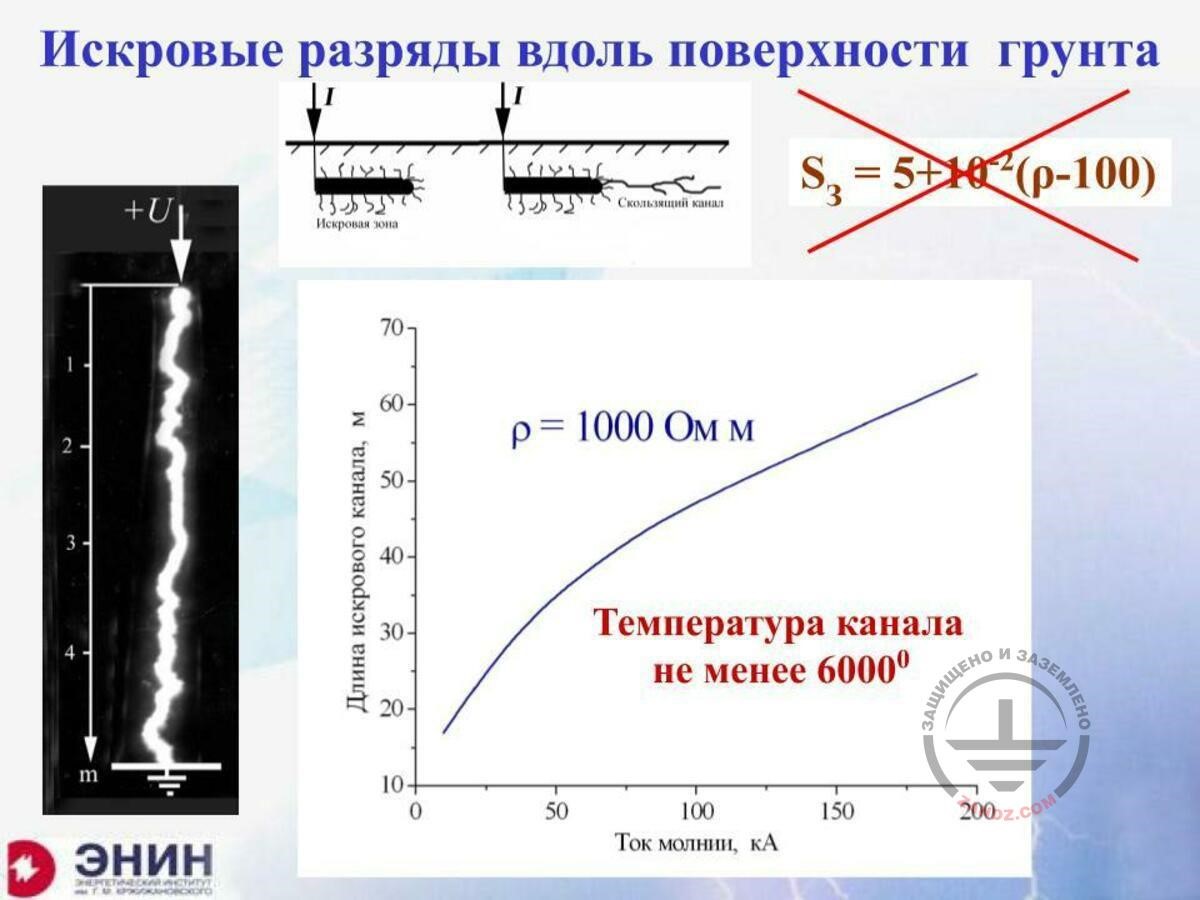
Spark discharges along the soil surface
| Искровые разряды вдоль поверхности грунта | Spark discharges along the soil surface |
| Ом м | Ohm m |
| Температура канала не менее 6000° | Channel temperature not less than 6,000° |
| Длина искрового канала, м | Spark channel length, m |
| Ток молнии, кА | Lightning current, kA |
| Искровая зона | Spark zone |
Now, let's look into it further. What do we have to talk about? Fire fighters say that we must not install lightning arresters on the explosive or fire hazardous buildings. We have to use the protection with standalone lightning arresters. We will get back to this issue from another point, and now I want to tell you: what is a standalone lightning arrester? If you read instructions RD 34, you will see that a standalone lightning arrester is the arrester that is spaced in air or along the earth from the protected facility at the distance of several meters. The distance is standardized depending on the facility height, but we are talking about the distances of 3 to 5 meters. It means that if I install a lightning arrester further for 5–10 meters, then it is surely a standalone lightning arrester. The fire fighters are satisfied with it and the lightning current from it does not get into the facility. We have already examined this issue. As a matter of fact, when the lightning strikes the lightning arrester, a creeping spark channel goes from its earthing device, which is usually a foundation. And such creeping spark channel bears a temperature of about 6,000 degrees and may have a length of several dozens meters. Especially if these are high-ohmic soils, e.g., 3,000 Ohm*m or 1,000 Ohm*m.
| Незавершенные разряды | Incomplete discharges |
| РД 34.21.122-87 | RD 34.21.122-87 |
| Реальность | Real conditions |
| Нисходящая молния | Downward lightning |
| Незавершенный разряд | Incomplete discharge |
| Горючий газ | Flammable gas |
We have already discussed such situations. I provided examples, e.g., when the rocket missiles flew apart after the lighting strike into the lightning arrester, when its current formed a channel. Such channel passed a distance of about 20 meters, reached the boxes with the rocket missiles, their igniters triggered, and these missiles flew apart. Therefore, you should not omit such situation during the lightning protection design. I have already told you how to protect against such channels. I offer to lay the closed circuit into the earth that delineates the hazardous territory. The channel will reach such metal circuit. The lightning current will flow along the channel, and the channel development will stop. One more dangerous thing is igniting the combustible emissions that are provided by breathing valves of the tank farms of different purpose. Owing to the fire fighters, such strict requirement was specified in our RD 34. The protection zone of the lightning arrester that protects the tanks must include the reservoir itself and the zone of the combustible gases release. It must be done. What is this requirement associated with? This is simple. If such combustible mixture comes in contact with the high-temperature lightning channel, it ignites, and the flame penetrates the tank and the following thing happens as shown in the figure below. But you know, the photo I have shown to you was made in the location where no storm ever happened. At the territory of this tank farm, no lightning discharges ever occurred during the fire. This fact is strictly recorded and undoubtful. However, the fire took place, and you can see its consequences. Why such fire might occur? It is not necessary for the lightning to strike this tank; however, the following situation may happen. Here you have got a breathing valve. An opposed spark discharge may develop from the breathing valve towards the lightning channel. What length should this channel have to ignite the explosive or fire-hazardous mixture? Take your electric cigar lighter, if you smoke. And look at its spark. The spark is 2–3 mm long and it may burn this explosive mixture. What can we do then? Eliminate such channels. This is the first thing that comes to my mind, and with this, the fire safety issue will be resolved. But which sparks can put it on fire and which of them cannot? The first question we may answer is simple. Probably all sparks may cause fire, if such small 2–3 mm spark may. And the answer to this question is absolutely unambiguous. Since the spark in the lighter may cause fire, it means that its temperature is rather high. But ionization processes that may happen in real conditions, may be few dozens centimeters long. Nevertheless, their temperature will not exceed the ambient temperature for even 100 degrees. Such streamer discharges are known to specialists. The lightning protection experts and fire fighters have begun studying them only recently. And fire fighters have begun to ask the following question: what requirements should be met so that such a small spark could put something on fire?
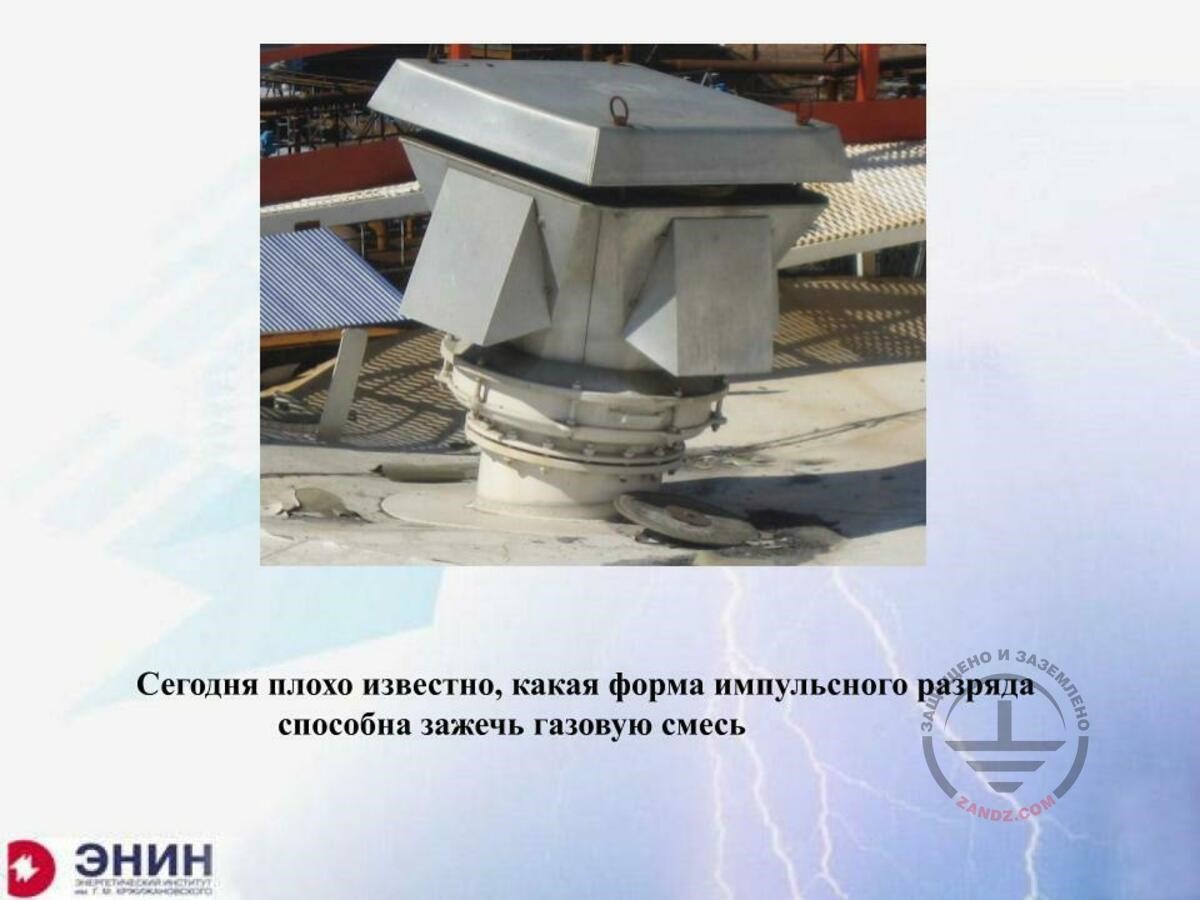
What charge may ignite the gas mixture?
| Сегодня плохо известно, какая форма импульсного разряда способна зажечь газовую смесь | People hardly know today what pulse discharge shape may ignite the gas mixture |
As you can see, a breathing valve has a very complicated structure. It has got locations of small curve radii, and there are locations in it wherein the opposed charges may occur during the storm. What charges are dangerous? Today, I cannot answer this question although I carefully study the work that is being performed in this regard presently. The only thing I can say is that if you want to avoid ignition of flammable emissions, you can do virtually nothing for it yet. Because no matter what shields you use for such breathing valves, there will always be a hazard that ionization would take place somewhere due to the fact that a bird seats somewhere and rises its head thus strengthening the electrical field. Can you see that? Therefore, only one way out is available for you: ignore explosions and ignitions of these flammable gases and do the following. Do it so that to avoid entering this flammable hot wave into the tank's interior through the breathing valve. The lightning protection area may not solve this issue today. The solution is in that the fire barrier system must not let the flame go into the tank's interior from the external surface. We should have a reliable fire barrier system. This allows you to stop using the lightning protection associated with fire safety. Because this flame may occur and go out if it does not enter the interior. Such solutions exist in some countries such as the USA. The lightning protection there does not exist in the sense that requires elimination of explosions of breathing emissions. Because a reliable fire barrier system is operated there. We have to think of it because today, unfortunately, we do not have any other approach.
| Нормативные требования | Regulatory requirements |
| 1. РД 34.21.122-87 - | 1. RD 34.21.122-87 |
| - отдельно стоящие молниеотводы, | - standalone lightning arresters, |
| - включение в зону защиты газовых выбросов, | - addition of gas emissions to the protection zone, |
| - защита от заноса высоких потенциалов. | - protection against high potentials. |
| 2. Норматив 2003 г - | 2. Standard of 2003 - |
| - специальных требований нет. | - no special requirements. |
| 3. Стандарт МЭК IEC 62305 - | 3. Standard IEC 62305 - |
| - не распространяется на предприятия добычи, транспортировки и переработки газа, которые являются специальными объектами. | - does not apply to the gas upstream and downstream companies which are considered to be special facilities. |
| Многократные молниеотводы | Multiple lightning arresters |
| Стержневые молниеотвода | Lightning rods |
| h = 40 м | h = 40 m |
| Расстояние между молниеотводами – 100 м | Distance between the lightning arresters — 100 m |
| В реальности объект диаметром 100 м и высотой 27,5 м защищен с надежностью 0,99! | In real life, the facility with a diameter of 100 m and a height of 27.5 m is protected with a reliability of 0.99! |
| Зоны защиты на высоте 27,5 м по РД 34.21.122-77 | Protection zones at the height of 27.5 m according to RD 34.21.122-77 |
And now, what can we do to improve the environment in terms of fire safety? The first thing we can do and have already discussed before is to use the multiple lightning arrester system. Because the multiple lightning arrester system allows achieving high protection reliability with a relatively low lightning arrester's height. I will provide you with an example. By the way, I did that during some webinars. Here, we have got a large tank that is 27.5 meters high. The diameter of this tank is 100 meters. Here are four lightning rods. These lightning rods are 40 meters high. If I generate the protection zone for these lightning arresters as it is required by the regulatory documents, they will be such narrow bands. It appears that the remaining space is not protected in terms of these protection zones. But if you use the software specified in SO 153, it will turn out that the entire reservoir is protected with a reliability of 0.99 using relatively low lightning arresters. Why do I insist on low lightning arresters? Because if the lightning arresters are high, they will attract the lightning discharges. If these lightning discharges are attracted, they will promote incomplete discharges that may put this mixture on fire and, the most important, cause electromagnetic interference that destroy the entire automation of the fire extinguishing system. If you are concerned with the operation of the automation of the fire extinguishing system, and the experience frequently shows that it does not operate due to the fact that remote storm effects lead to the failure of all microprocessor hardware in this automation. As a result, your facility is unprotected.
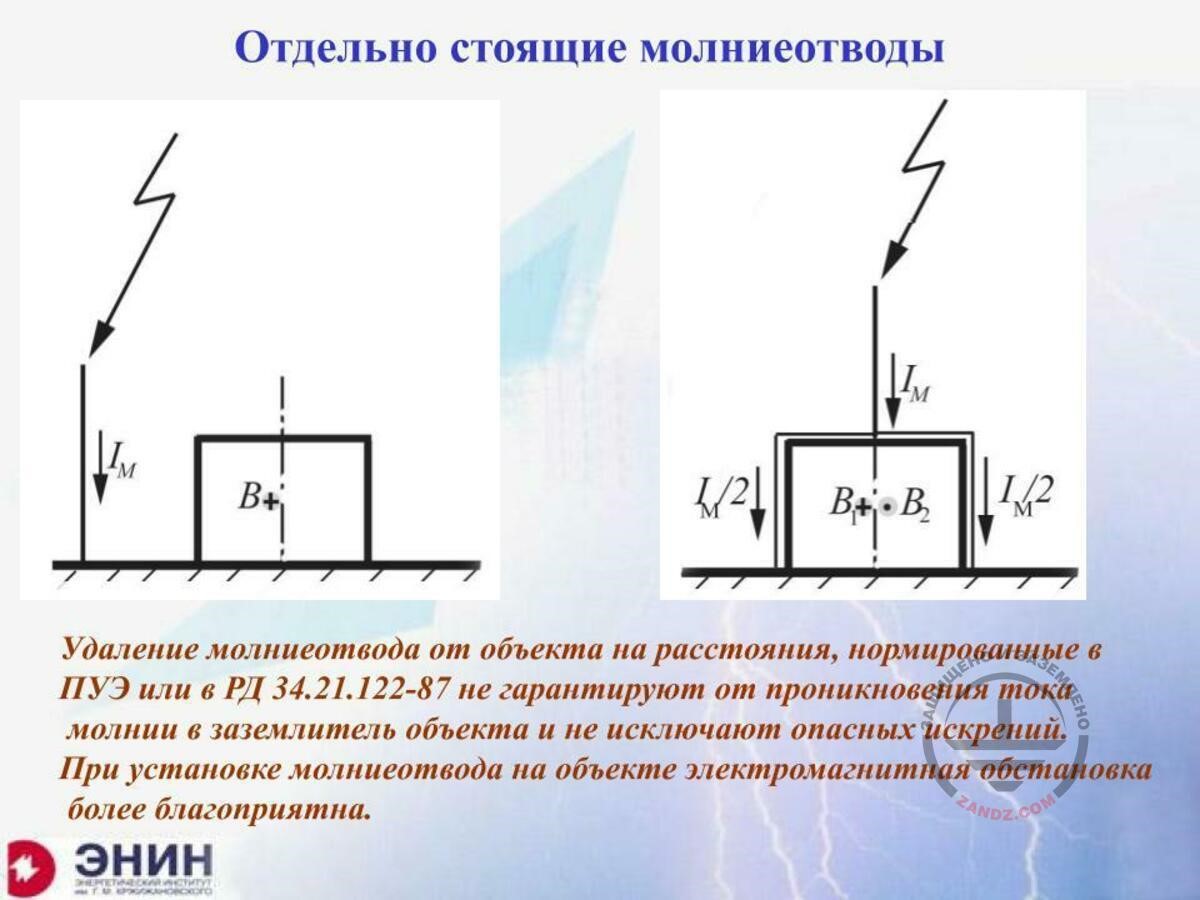
Standalone lightning arresters
| Отдельно стоящие молниеотводы | Standalone lightning arresters |
| Удаление молниеотвода от объекта на расстояния, нормированные в ПУЭ или в РД 34.21.122-87 не гарантируют от проникновения тока молнии в заземлитель объекта и не исключают опасных искрений. | Placing the lightning arrester at the distances from the facilities, rated in the EIC or in RD 34.21.122-87, do not allow avoiding the lightning current entering the earthing device of the facility and do not eliminate dangerous spark formation. |
| При установке молниеотвода на объекте электромагнитная обстановка более благоприятна. | In case of installation of a lightning arrester at the facility, the electromagnetic environment is more favorable. |
Therefore, the first thing you must do is to make lightning arresters of a minimum height, so the number of dangerous impacts will reduce. You will stop attracting the lightning strikes. Reduction in the lightning arrester's height is always the improvement in fire safety conditions. The second point. I have already told about the standalone lightning arresters. The directions of fire fighters do not permit to install standalone lightning arresters on the roof of explosive and fire hazardous buildings. They require this installation (figure on the left). Let's look at what this installation may save you from? The distance from the lightning arrester to the internal volume wherein a fire hazardous situation is located is not more than 10 meters. When the lightning strikes the lightning arrester and the lightning current flows along the lightning arrester, a magnetic field is created inside this facility. This magnetic field creates the electromotive force of magnetic induction we discussed in the previous seminars. As a result, spark formation occurs in the spark gaps and explodes the entire facility. From this standpoint, installation of the lightning arrester on the building roof is more beneficial for the following reason. You have got at least two current collectors now, along which the lightning current is drained to the earth. If you use the right-hand screw rule for magnetic flux, then the magnetic fluxes from the right and left current collectors are directed oppositely. They are subtracted from each another. As a result, your magnetic field is weakened, and it becomes even equal to zero along the axis of this facility. By increasing the number of current collectors, you may significantly reduce the magnetic field inside the explosive building. And as a result, you may destroy or even significantly reduce the risk of spark formation due to electromagnetic interference. Therefore, by increasing the number of current collectors, you may thereby significantly reduce the risk of electromagnetic effects, and as a result, the conditions in terms of fire safety in the explosive premises are improved. The increase in the number of current collectors is always a good thing.
| Вопросы молниезащиты кровли зданий | Lightning protection issues |
| Основные положения | Basic provisions |
| - Молниеприемная сетка на кровле не только никак не защищает размещенное там оборудование и людей, но даже железобетонные плиты крыши. | - The lightning protection grid on the roof does not protect equipment and people located there and even the reinforced concrete plates of the roof. |
| - Для защиты от прямых ударов молнии следует применять стержневые и тросовые молниеотводы, предпочтительно многократные, чтобы не увеличивать заметно высоту сооружения, а вместе с ней число опасных воздействие электромагнитного поля тока молнии. | - To protect against the direct lightning strikes, you should use rod or wire lightning arresters, preferably multiple, so that not to increase significantly the structure’s height, and along with it, the number of dangerous effects of the electromagnetic field of the lightning current. |
| - Поскольку надежность защиты от прямых ударов молнии при прочих равных условиях снижается с высотой здания, желательно отказаться от использования крыши зданий высотой более 100-150 м для массового размещения людей и аппаратуры. | - Since the reliability of protection against the direct lightning strikes, if the conditions are otherwise equal, is reduced with the building height, it is desirably to refuse to use the building roofs with the height of over 100–150 m for the mass location of people and equipment. |
| - Установка молниеотводов на крыше высотных зданий для защиты вертолетных площадок само по себе повлечет большую опасность, чем удар молнии. | - Installation of lightning arresters on the roofs of high-rise buildings to protect the helipads will lead to the greater danger than the lightning strike. |
Now, let's talk about the lightning protection of the building roofs. The most typical lightning protection system is a grid on the building roof. We already discussed such grid many times. Document RD 34 states that the used grid contains cells of 6 x 6 meters, if it is a facility of the second category of lightning protection or the grid with the cells of 12 x 12, if this is the third protection category. The grid is installed over a coating on the roof if it is flammable. If it is not, it may be laid under such coating. Document RD 34 states these requirements. Now let's think. Imagine that the coating is flammable and we have installed the grid on top of it. The fire fighters think that the lightning may strike only this grid and that it may not strike the coating under which the reinforced concrete plate is located. This is a complete mistake. The grid placed onto the flammable coating does not protect it from the lightning strike in any case. It just does not happen.
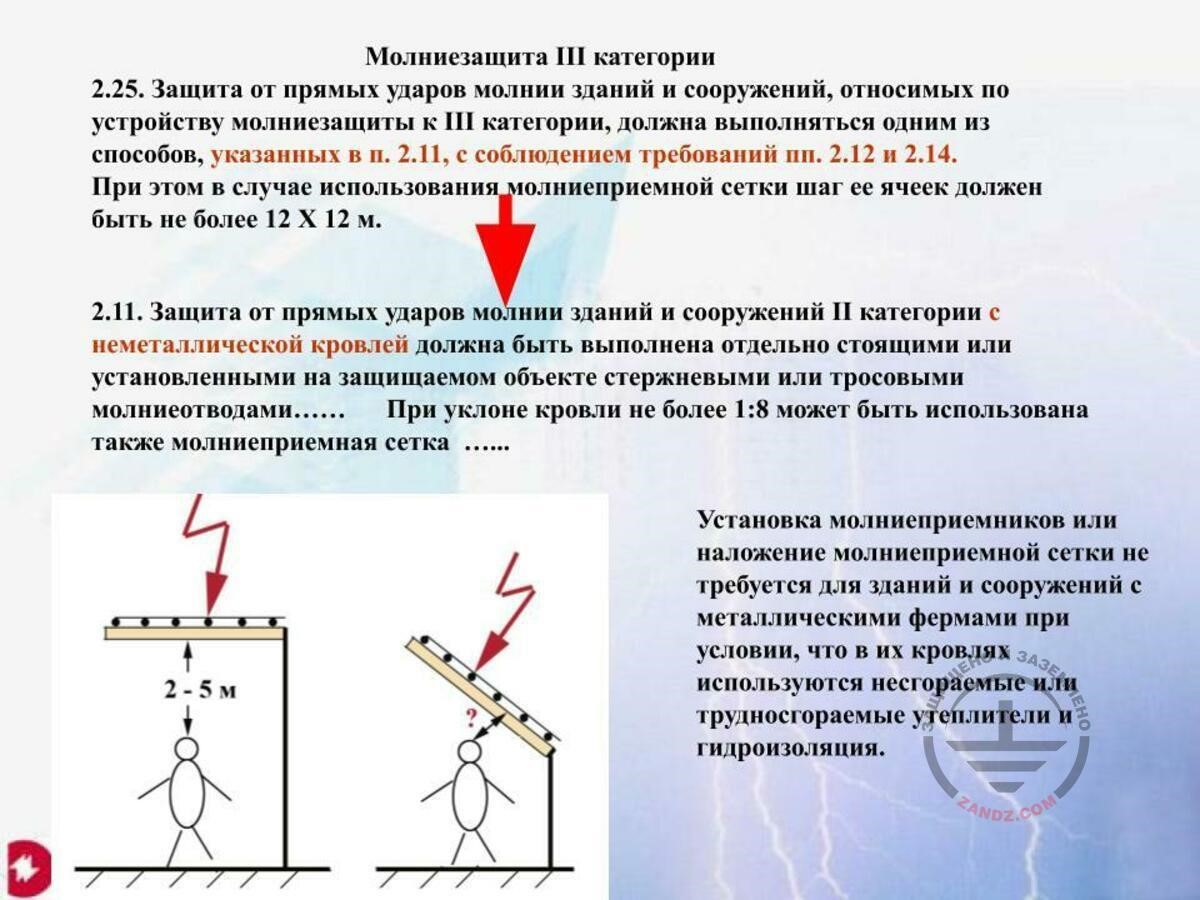
Category III lightning protection
| Молниезащита III категории | Category III lightning protection |
| 2.25. Защита от прямых ударов молнии зданий и сооружений, относимых по устройству молниезащиты к III категории, должна выполнятсья одним из способов, указанных в п. 2.11, с соблюдением требований п.п. 2.12 и 2.14. При этом в случае использования молниеприемной сетки шаг ее ячеек должен быть не более 12 Х 12 м. | 2.25. Protection against the direct lightning strikes into buildings and structures that refer to Category III in terms of lightning protection should be made in one of the ways specified in item 2.11 while complying with items 2.12 and 2.14. In this case, if the lightning protection grid is used, its cells step should not be more than 12 X 12 m. |
| 2.11. Защита от прямых ударов молнии зданий и сооружений II категории с неметаллической кровлей должна быть выполнена отдельно стоящими или установленными на защищаемом объекте стержневыми или тросовыми молниеотводами…… При уклоне кровли не более 1 : 8 может быть использована также молниеприемная сетка …… | 2.11. Protection against the direct lightning strikes into buildings and structures of Category II with non-metal roofs must be made with standalone rod or wire lightning arresters or with those installed on the protected facility… … With the roof inclination not more than 1 : 8, a lightning protection grid may also be used…… |
| Установка молниеприемников или наложение молниеприемной сетки не требуется для зданий и сооружений с металлическими фермами при условии, что в их кровлях используются несгораемые или трудносгораемые утеплители и гидроизоляция. | Installation of lightning arresters or a lightning protection grid is not required for the buildings and structures with metal frames if inflammable or hardly flammable heat insulators and waterproofing are used in their roofs. |
How did this grid appear and what is it intended for? If you read document RD 34 thoroughly, you will see that the grid is used for the protection of dielectric coatings underneath of which people or equipment are located. If you have got a reinforced concrete roof, then the use of the grid provides no effect at all. This fact has not been used in the lightning protection practice until present. We persistently design buildings with the grids that are installed over the reinforced concrete plate of the roof. Why? No one knows that. Do you understand it? I understand that I cannot ask you to stop installing grids as it is pointless. If you do that, you will have a lot of trouble with Gostekhnadzor that will see the absence of the grid and will make you install it. Therefore, you should not do this. But if you have got a building and want to protect the roof that is actually fire hazardous or expensive and you should avoid its damage, then install rod or wire lightning arresters in addition to this grid.
<< Previous page
slides from 1 to 9
Next page >>
slides from 18 to 26
Related Articles:
 5. Boundary between soil and air
5. Boundary between soil and air
 6. How to do that?
6. How to do that?


